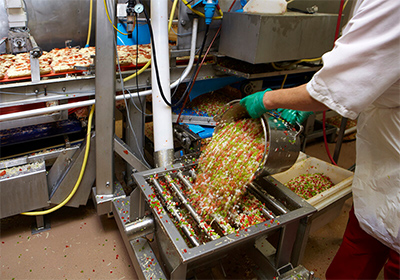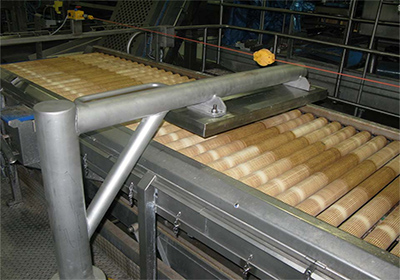-

ส่งอีเมลถึงเรา
sale@lscmagnetics.com -

เบอร์ติดต่อ
+86 -13559234186

ส่งอีเมลถึงเรา
sale@lscmagnetics.com
เบอร์ติดต่อ
+86 -13559234186
วัสดุแม่เหล็กในกระบวนการแปรรูปอาหาร: “ผู้พิทักษ์” ที่มองไม่เห็น จะรับประกันความปลอดภัยและประสิทธิภาพได้อย่างไร?
Jul 23, 2025

ในโรงงานแปรรูปอาหารที่มุ่งเน้นความอร่อยและสุขภาพ คุณอาจไม่นึกถึง "แม่เหล็ก" ในตอนแรก อย่างไรก็ตาม แรงแม่เหล็กที่มองไม่เห็นเหล่านี้มีบทบาทสำคัญในการสร้างความมั่นใจในความปลอดภัยของโต๊ะอาหารของเราและเพิ่มประสิทธิภาพการผลิต แม้จะไม่มีใครรู้จัก แต่พวกมันก็มีความรับผิดชอบอันยิ่งใหญ่ พวกมันถูกออกแบบมาโดยเฉพาะเพื่อจัดการกับ "แขกที่ไม่ได้รับเชิญ" ที่อาจปนเปื้อนอยู่ในอาหาร นั่นคือ สิ่งสกปรกที่เป็นโลหะ
* แหล่งที่มาที่หลากหลาย: สิ่งเจือปนโลหะอาจมาจากวัตถุดิบ (เช่น เศษชิ้นส่วนเครื่องเก็บเกี่ยวและเศษแร่ในเมล็ดพืช) อุปกรณ์การผลิต (เช่น การสึกหรอของตะแกรง ชิ้นส่วนเครื่องจักรที่หลวมและหลุดร่วง) ความประมาทของพนักงาน (เช่น สกรู แหวนรอง) และแม้กระทั่งวัสดุบรรจุภัณฑ์
* อันตรายมหาศาล:
ความเสียหายทางกายภาพ: เศษโลหะที่แหลมคมถือเป็นภัยคุกคามสำคัญต่อความปลอดภัยของผู้บริโภค และอาจทำให้เกิดความเสียหายต่อช่องปาก หลอดอาหาร และแม้แต่ต่ออวัยวะภายในได้
ความเสียหายของอุปกรณ์: อนุภาคโลหะแข็งสามารถสึกหรอหรือกระทั่งทำให้เครื่องบด เครื่องเจียร ปั๊ม วาล์ว และอุปกรณ์สำคัญอื่นๆ ที่มีราคาแพงติดขัดได้ ทำให้เกิดเวลาหยุดทำงานโดยไม่คาดคิดและต้นทุนการซ่อมแซมที่สูง
ความเสี่ยงด้านชื่อเสียงและกฎหมาย: เมื่อผลิตภัณฑ์ที่มีสิ่งแปลกปลอมที่เป็นโลหะเข้าสู่ตลาด ผลิตภัณฑ์เหล่านั้นจะนำไปสู่การร้องเรียนของผู้บริโภค การเรียกคืนสินค้าเป็นจำนวนมาก ความเสียหายร้ายแรงต่อชื่อเสียงของแบรนด์ และอาจต้องเผชิญกับบทลงโทษทางกฎระเบียบและการฟ้องร้องที่รุนแรง
ปัจจัยข้างต้นเป็นขั้นตอนที่เครื่องแยกแม่เหล็กมีบทบาทสำคัญ เครื่องแยกแม่เหล็กใช้สนามแม่เหล็กที่เกิดจากแม่เหล็กถาวรกำลังสูง (เช่น นีโอดิเมียม เหล็ก โบรอน) หรือแม่เหล็กไฟฟ้า เพื่อ "จับ" โลหะเฟอร์โรแมกเนติก (เหล็ก เหล็กกล้า) และโลหะบางชนิดที่มีแม่เหล็กอ่อน (เช่น สเตนเลสสตีล) ได้อย่างแม่นยำ ณ จุดสำคัญของกระบวนการแปรรูปอาหาร หลักการทำงานคือ เมื่อวัตถุดิบอาหารไหลผ่านหรือเข้าใกล้บริเวณที่มีสนามแม่เหล็กแรงสูง สิ่งเจือปนโลหะเฟอร์โรแมกเนติกในวัตถุดิบจะถูกดูดซับอย่างแน่นหนาด้วยแรงแม่เหล็ก ในขณะที่อาหารบริสุทธิ์จะไหลผ่านได้อย่างราบรื่น ทำให้สามารถแยกได้อย่างแม่นยำ
อุตสาหกรรมอาหารใช้อุปกรณ์แยกแม่เหล็กประเภทใดบ้าง?
อุปกรณ์แยกแม่เหล็กมีหลายประเภทที่ใช้กันทั่วไปในอุตสาหกรรมแปรรูปอาหาร ได้แก่:
แม่เหล็กแผ่น:แผ่นแม่เหล็กแบนเหล่านี้มักพบในสายพานลำเลียงหรือราง มักใช้เพื่อกำจัดสิ่งปนเปื้อนโลหะออกจากสินค้าแห้ง เช่น เมล็ดธัญพืช เมล็ดพันธุ์ หรืออาหารสัตว์เลี้ยง
แม่เหล็กกริด:แม่เหล็กแบบกริดก็เหมาะสำหรับการใช้งานกับวัสดุแห้งเช่นเดียวกับแม่เหล็กแผ่นเช่นกัน ตัวแยกแม่เหล็กเหล่านี้ประกอบด้วยแท่งแม่เหล็กหลายแท่งที่วัสดุจะผ่านเข้าไป แท่งแม่เหล็กจะรวบรวมและกำจัดสิ่งเจือปนเหล็กออกจากวัสดุ แม่เหล็กแบบกริดมีให้เลือกหลายแบบเพื่อให้เหมาะกับวัสดุหลายประเภท เช่น แป้ง ธัญพืช น้ำตาล และอื่นๆ
แม่เหล็กหมุน:แม่เหล็กเหล่านี้มีประสิทธิภาพมากที่สุดสำหรับผลิตภัณฑ์ที่แห้ง เหนียว และไหลยากซึ่งมีปัญหาด้านการเชื่อมโยง เช่น นมผงหรือน้ำตาล
แม่เหล็กอินไลน์: เครื่องแยกแม่เหล็กประเภทนี้มีการออกแบบที่เหมาะสำหรับการใช้งานทั้งแบบแห้งและแบบเปียก รวมไปถึงสายผลิตภัณฑ์ความเร็วสูง สายปั๊ม และการลำเลียงด้วยลม


เทคโนโลยีการแยกแม่เหล็กช่วยให้มั่นใจถึงความปลอดภัย ไม่เพียงแต่อุปกรณ์เท่านั้น แต่ยังรวมถึงระบบด้วย
* ปฏิบัติตามกฎระเบียบและมาตรฐาน: ระบบ HACCP (การวิเคราะห์อันตรายและจุดควบคุมวิกฤต), ISO 22000, FSSC 22000 และมาตรฐานความปลอดภัยด้านอาหารระดับโลกอื่นๆ ล้วนกำหนดให้การควบคุมสิ่งแปลกปลอมโลหะเป็นจุดควบคุมวิกฤต (CCP) หรือโปรแกรมเบื้องต้น (PRP) เครื่องแยกแม่เหล็กประสิทธิภาพสูงคือฮาร์ดแวร์พื้นฐานที่ตอบสนองข้อกำหนดเหล่านี้
* การเลือกและการตรวจสอบอุปกรณ์: ความแข็งแรงของแม่เหล็ก รูปแบบ และตำแหน่งการติดตั้งต้องได้รับการคัดเลือกอย่างเป็นวิทยาศาสตร์ โดยพิจารณาจากคุณสมบัติของวัสดุ (แห้ง/เปียก ขนาดอนุภาค อัตราการไหล) ขนาดและชนิดของโลหะที่คาดหวัง ต้องมีการตรวจสอบประสิทธิภาพของอุปกรณ์เป็นประจำ (เช่น การใช้ชิ้นส่วนทดสอบมาตรฐาน)
* ขั้นตอนการบำรุงรักษาที่เข้มงวด: นี่คือเส้นชีวิตที่ช่วยให้มั่นใจถึงประสิทธิภาพอย่างต่อเนื่องของอุปกรณ์แยกแม่เหล็ก! ต้องจัดทำและดำเนินการดังนี้:
* การทำความสะอาดปกติ: ทำความสะอาดสิ่งสกปรกโลหะที่ดูดซับอยู่บนพื้นผิวของแม่เหล็กตามแผน (เช่น ทุกกะ ทุกวัน) เพื่อป้องกันการสะสมที่ก่อให้เกิดการป้องกันสนามแม่เหล็กหรือการผสมซ้ำของสิ่งสกปรก
* การตรวจสอบตามปกติ: ตรวจสอบว่าแม่เหล็กได้รับความเสียหายหรือไม่ เคลือบอยู่ครบถ้วนหรือไม่ (เพื่อป้องกันการปนเปื้อนของอาหาร) และแรงแม่เหล็กถูกลดทอนลงหรือไม่ (ใช้เครื่องวัดเกาส์ในการทดสอบเป็นประจำ)
* บันทึกและการตรวจสอบย้อนกลับ: บันทึกโดยละเอียดของการทำความสะอาด การตรวจสอบ และสิ่งเจือปนโลหะที่พบเพื่อให้แน่ใจว่ากระบวนการนั้นสามารถตรวจสอบย้อนกลับได้
ในสาขาการแปรรูปอาหาร วัสดุแม่เหล็กและเทคโนโลยีการแยกสารเหล่านี้ไม่ใช่บทบาทสนับสนุนที่ขาดไม่ได้ พวกมันคือรากฐานสำคัญของการสร้างสายการผลิตที่ปลอดภัยต่อความปลอดภัยทางอาหารและเป็นผู้ปกป้องการดำเนินงานที่มีประสิทธิภาพของสายการผลิต การสกัดโลหะเจือปนทุกชนิดที่อาจเป็นอันตรายตั้งแต่ต้นทาง ถือเป็นการแสดงให้เห็นถึงความรับผิดชอบของอุตสาหกรรมอาหารสมัยใหม่ต่อสุขภาพของผู้บริโภค และเป็นการลงทุนที่ชาญฉลาดสำหรับบริษัทต่างๆ เพื่อให้บรรลุเป้าหมายการพัฒนาที่ยั่งยืนและได้รับความไว้วางใจจากตลาด
ดังนั้นโปรดใส่ใจกับ "ผู้พิทักษ์ที่มองไม่เห็น" เหล่านี้:
* คัดสรรอุปกรณ์แยกแม่เหล็กที่เหมาะสมอย่างเป็นวิทยาศาสตร์
* ปฏิบัติตามขั้นตอนการบำรุงรักษาและทำความสะอาดอย่างเคร่งครัด
* บูรณาการอย่างล้ำลึกเข้ากับระบบการจัดการความปลอดภัยด้านอาหารของคุณ